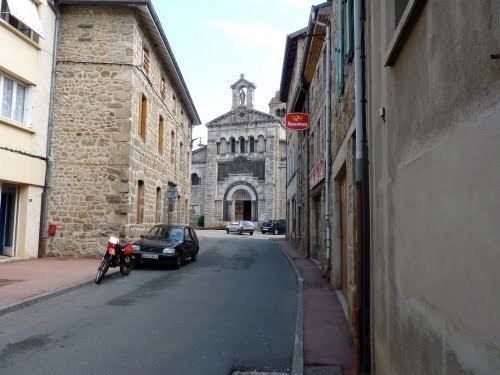Area 30.26 km² | Intercommunality Monts du Pilat Local time Wednesday 2:41 AM | |
 | ||
Weather 7°C, Wind N at 3 km/h, 83% Humidity | ||
Saint-Sauveur-en-Rue is a commune in the Loire department in central France.
Contents
- Map of 42220 Saint Sauveur en Rue France
- Geography
- History
- Draft establishment of wind
- Roads
- Nearest motorway
- Transport
- References
Map of 42220 Saint-Sauveur-en-Rue, France
Geography
Saint Sauveur en Rue is located in the south of the Parc Naturel Regional du Pilat, it is the southernmost town of the department of the Loire departement. Saint Sauveur is located 6 km from Haute-Loire departement, 10 km from the Ardèche departement.
The village is situated at the foot of Mont Pyfarat culminating a 1381 m above sea level and is located on the outskirts of the forest of Taillard. The village is situated at the foot of two pass mountains known throughout the region and even throughout France: Col de la République (by going to Saint Etienne) and the Col du Tracol (go to Le Puy en Velay). The town is on the border of sharing water. The village is also located below the bog Gimel. Saint Sauveur village which is particularly popular because the village is located on the obligatory passage for people who want to join the Rhone Valley (which is very attractive) of the Haute-Loire and vis-versa. The village is located at 22 km from Annonay and 25 km south of Saint-Étienne and 48 km from Yssingeaux.
The Déôme river, feeding the city Annonay, rises below the Tracol. The village is the highest village in the valley.
History
Saint-Sauveur-en-Rue is a pretty old town, which has particularly flourished in the Middle Ages. Indeed, Tracol was the gateway to the merchants from the Rhone Valley in Puy-en-Velay.
Complement "rUE" in its name probably comes from the name of the nearby castle of Ru, which may be named from the Germanic word "Ruda", which means clearing.
In 1061, the lord of Artaud Argental bequeathed his property to the monks of La Chaise-Dieu, for they build a priory Saint-Sauveur-en-Rue (1062-1401). Pilat is so sparsely populated.
Saint-Sauveur had fortifications which there are some remains near the retirement home, a watchtower and a door above the gym.
The town is surrounded by the fortified house of Ru and Bobigneux Castle (now a hostel).In the seventeenth century, were dug underground between the castles and churches of the canton.
The village has 35 cross, whose principal is on a rock, this is the cross of Perthuis or ascension. This cross is the most important because the procession stopped in front of the rock to the priest bless the participants. This cross pin is in the D503 at the place called the Griotet (above the industrial area). These crosses are built in the seventeenth century and have been preserved during the French Revolution by the villagers.
During the Revolution, March 16, 1794, Father Robert, vicar of Saint-Sauveur-en-Rue, refractory priest who refused to take the oath was executed after Lyon secretly confessed many defendants.
Saint-Sauveur-en-Rue has become prosperous in the early twentieth century with the exploitation of the forest for wood Taillard shoring mines all around Saint-Étienne and weaving together for the printing. Saint-Sauveur-en-Rue was then connected by train (Line Saint-Rambert D'Albon - Firminy).
In the early 1970s, a seismic sensor station was built in the old railway tunnel Badol (hamlet east of Saint-Sauveur-en-Rue). Its importance has increased since 1993, it has detected the earthquake in Chile in 2010, Japan in 2011 and Sumatra in 2004.
Today, the village is mainly a dormitory village, many people working in Saint-Étienne, the basin annonéen and the Rhone Valley. However, there are many artisans and shops. Currently, the inhabitants are called "picatios ane" (stephanois patois word that means "ass pic ass", because at the time it was the only way forward donkeys on the rise the Tracol).
During the Second World War, in 1944, the Allies had damaged a tank with a sidewalk (now repaired). The path between the Tracol to the cross Cerralier (GR65, GR7) was made by German prisoners.
Draft establishment of wind
A wind farm project is underway Pyfarat (climax forest Taillard), the village of Burdignes associated with this project. In 2010 the two villages voted to agree to start studying a year (late 2012-late 2013) and if the studies are positive, the end of 2014 wind turbines will stand.
Roads
Nearest motorway
N88:
A7:
